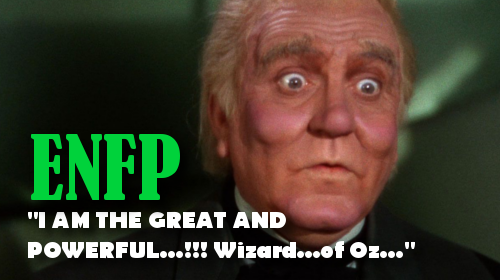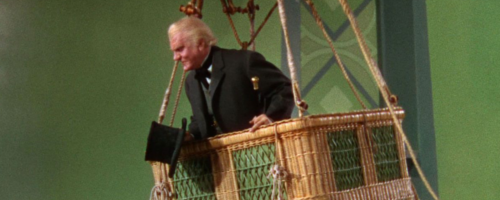The Champion
There are two ways we can look at the characters in the land of Oz: one, as fully realized persons in their own right; and two, as personifications of the different parts of Dorothy’s personality. It really depends on whether you go with it all being a dream, or if you prefer to believe it was real. Of course, some people do go both ways.
The Wizard of Oz himself is at once an interesting, complicated character with his own backstory, and also a metaphor for Dorothy’s wild imagination and indecision. Let’s take a look.
Dominant Function – Extraverted Intuition/Ne, “What Could Be”
 A mark of a strong Ne user (hi, I’m an INFP!) is the ability to BS our way through new and unfamiliar situations. The Wizard is a master at this. As he tells it, he crash-landed in Oz and was promptly named the Wizard everyone was waiting for (I’m not gonna reference the 2013 James Franco movie here, so you can just forget about that).
A mark of a strong Ne user (hi, I’m an INFP!) is the ability to BS our way through new and unfamiliar situations. The Wizard is a master at this. As he tells it, he crash-landed in Oz and was promptly named the Wizard everyone was waiting for (I’m not gonna reference the 2013 James Franco movie here, so you can just forget about that).
“Times being what they were,” the Wizard tells Dorothy and her friends, “I accepted the job.” He clearly had no options or resources, so the Wizard jumped on the new opportunity and went with it. And when we finally meet him in the flesh, he’s been going with it for a very long time, pulling the wool over the eyes of everyone in the Emerald City and in Oz with elaborate, creative deceptions.
Unfortunately, he’s been using his creativity out of fear and selfishness. He clearly has no intention of helping Dorothy and her friends—because he can’t—so he makes up a bunch of excuses and sends them on a dangerous quest to kill the Wicked Witch. Dorothy, at the start of the movie, is also caught up in her own Ne, although it’s lower down in her cognitive function stack. So it’s not her strength, and I think the Wizard’s reckless use of his own Ne-dom reflects the way that Dorothy’s ungrounded desires have led her astray.
It isn’t until Toto unmasks him that the Wizard is forced to use his quick wits to directly help others. Even then, the Wizard is kind of BS-ing it as he pulls tricks from his bag, but this time he’s making helpful connections between what Dorothy and her friends need, and creating meaning from symbols to give them confidence. He’s still kind of conning them, but for a good cause.
Auxiliary Function – Introverted Feeling/Fi, “What Is Important”
 “I’m a very good man…I’m just a very bad wizard.” Despite all his chicanery—and the fact that he sent a young girl to face off against a powerful witch—the Wizard still believes he has good motives. He didn’t mean to hurt anyone. He was just trying to give people the Wizard that they wanted.
“I’m a very good man…I’m just a very bad wizard.” Despite all his chicanery—and the fact that he sent a young girl to face off against a powerful witch—the Wizard still believes he has good motives. He didn’t mean to hurt anyone. He was just trying to give people the Wizard that they wanted.
Once his deception is revealed, however, the Wizard’s conscience kicks in. Introverted Feeling can be very good for analyzing individuals and their particular needs (as opposed to Fe, which tends to feel the energy of a whole room). Channeled through his Ne-dom, the Wizard’s Fi helps him zero in on each of the emotional needs of Dorothy’s friends and provide them with symbols and advice that make them whole. He truly becomes a “Champion” for each of them.
Notice also that he knows just what to say to scare the dickens out of each of them when he’s pretending to be the Giant Talking Head.
Tertiary Function – Extraverted Thinking/Te, “How To Do It”
Just like Dorothy seems to be operating out of her tertiary function at the beginning of the story, so is the Wizard.
The Wizard uses his Te to hide behind his imposing persona, to intimidate and command people. When he’s rescued from his false life, he’s free to operate out of the strength of his higher functions, and his Te comes into play to add confidence to the gifts and words of wisdom he bestows upon Dorothy’s friends. He continues to play the part of ruler of Oz, but uses that authority to transfer power to one more able to handle it—the Scarecrow.
Inferior Function – Introverted Sensing/Si, “What Was”
The Wizard has a delightful memory for detail that brings his storytelling to life. However, this being his inferior function, he doesn’t quite remember how to make that darn balloon work. And so he accidentally drifts up and away out of Oz, leaving Dorothy to figure out how to get home on her own.
If the Wizard dramatizes Dorothy’s imagination set loose, the Wicked Witch of the West plays the part of her polar opposite. Her letters and her cognitive functions are exactly reversed from Dorothy’s, creating a shadow character who hinders and thwarts Dorothy all along the way. She’s an INTP, and she’s up next.
(Note: The line of pictures under the Extraverted Intuition header is just a reminder that Frank Morgan played several characters in Oz before he finally appeared as the Wizard. In my head canon, I like to think that the Doorman, the Cabbie, and the Guard are all actually the Wizard himself, scurrying from one costume to the next to keep an eye on the new arrivals. Since we don’t get to see him take all the forms he does in the book, I think it makes a fitting theory, and it seemed appropriate to group them all under Ne.)


